The latest deep-sea research vessel ‘Tamhae 3rd’ arrived on the 31st
Large ship weighing 6900 tons… Capable of continuous missions for 2 months
Equipped with high-performance sonar emitting and detection equipment
Deep-sea exploration similar to MRI and CT looking inside the human body
Determine the presence and location of oil, gas, and rare earth minerals
Operates not only in domestic coastal areas but also in the Pacific Ocean,
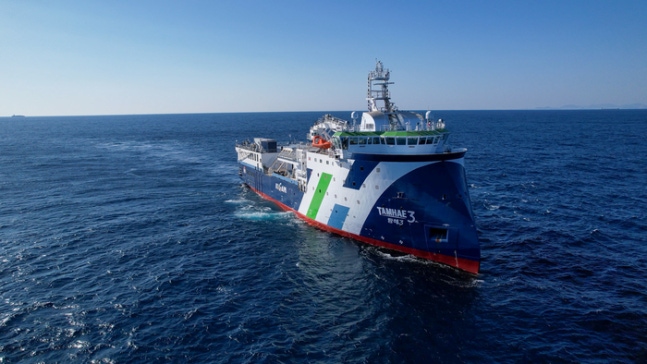
Korea’s latest deep-sea research vessel ‘Tamhae 3rd’ conducting a test operation near Busan last month. The Tamhae 3rd is equipped with precision sonar equipment for finding deep-sea resources. Provided by the Korea Institute of Geoscience and Mineral Resources,
,
, ‘On the 23rd of last month, it docked at the Busan Coastal Passenger Terminal. A passenger ferry is a kind of maritime bus that connects ships at sea to land. As the engine started and the ferry sailed for about 30 minutes, what came into view was ‘Tamhae 3rd’ floating near Busan.’,
,
, ‘When the ferry approached Tamhae 3rd and stopped, a 1-meter-long ladder was hung vertically for boarding. The ship was huge, measuring 92 meters in length and 21 meters in width. Its displacement was similar to that of a navy destroyer at 6900 tons.’,
,
, ‘Tamhae 3rd is the latest deep-sea research vessel operated by the Korea Institute of Geoscience and Mineral Resources. With an investment of 167.8 billion won, it was built by HJ Shipbuilding and launched in July last year. Since then, Tamhae 3rd has been conducting test operations. Even on the day it was shown to the press, Tamhae 3rd was conducting slow-speed test operations near Busan. Tamhae 3rd officially docked on the 31st of last month.’,
,
,
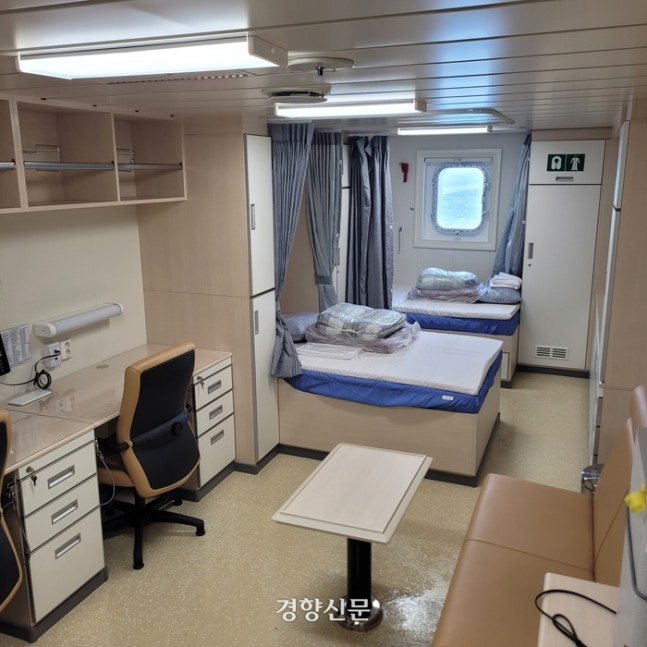
A 2-person cabin inside Tamhae 3rd. Equipped with a bed, desk, and living space, it is relatively spacious. Reporter Lee Jung-ho,
,
,
,
,
, ‘As I entered inside Tamhae 3rd, a narrow hallway appeared. It was so narrow that two adults couldn’t walk side by side. It was a typical view of the interior corridor of a ship.’,
,
, ‘However, when I pushed open a door next to the hallway and entered, a completely different space appeared. It was a cabin where researchers and crew members stayed. The 2-person cabin was equipped with a bed, bathroom, desk, and a small table and sofa. It was a relatively spacious area, similar in size to a 3-star hotel room.’,
,
, ‘Once Tamhae 3rd sets sail, it can perform missions for about 2 months. This means it can easily travel not only along the Korean coast but also to large oceans like the Pacific. Well-equipped living spaces help reduce stress during long-term exploration. Tamhae 3rd also has facilities for exercise and a hospital for health management. A total of 50 research and crew members are on board.’,
,
, ‘They moved to the deck to see the core equipment operated on Tamhae 3rd. After walking along the corridor and stairs for a few minutes, a device called an ‘air gun’ appeared.’,
,
,
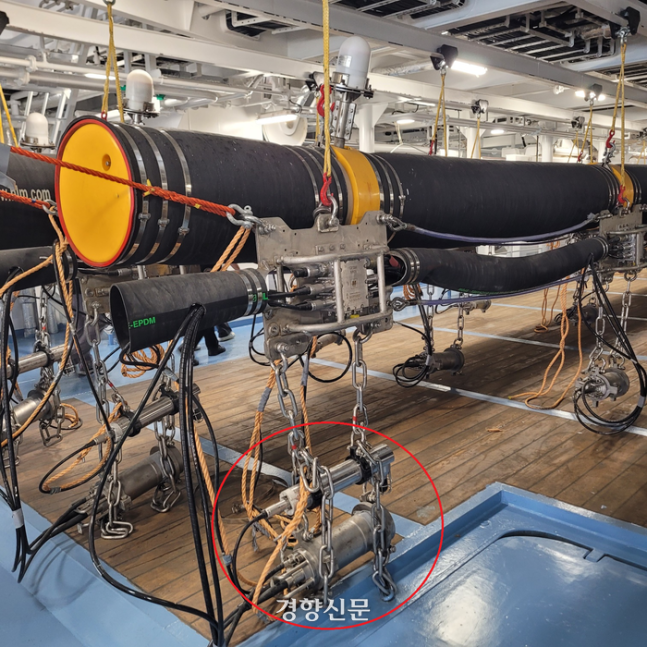
An ‘air gun’ (red circle) that emits a loud ‘boom’ sound, which is a device that generates seismic waves, stored inside Tamhae 3rd. Reporter Lee Jung-ho,
,
, ‘The air gun is a device that shoots air like a gun. It continuously emits seismic waves, a loud ‘boom’ sound, underwater.’,
,
, ‘The air gun had a shape similar to a household vacuum cleaner. Several of these air guns were hanging from large pipes providing buoyancy for floating in the sea.’,
,
, ‘The air gun uses air pressure of up to 2000psi to create sound. It is about 70 times stronger than the air pressure in a typical car tire (30psi). A Tamhae 3rd official said, “The vibrations transmitted to the ship from the submerged air gun are so strong that they can be felt.”‘,
,
,
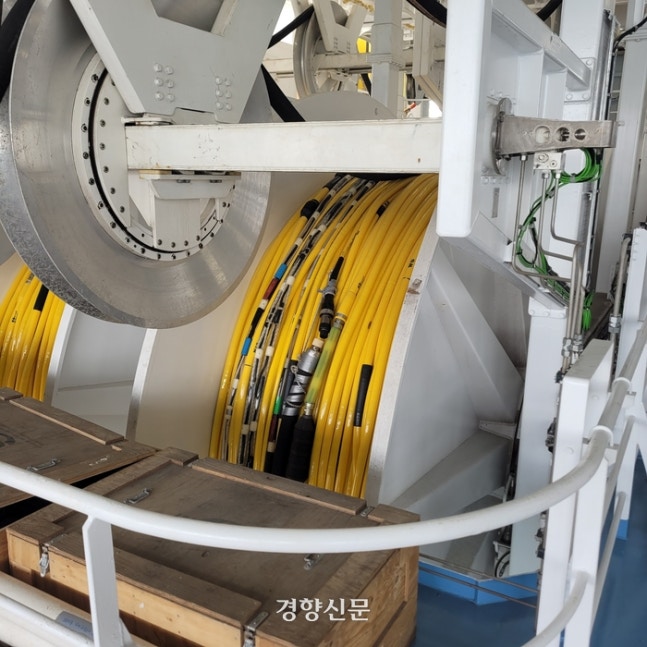
A ‘streamer’ wrapped around a round device resembling a paddle. The streamer detects the seismic waves that hit the seabed and return after being emitted from the air gun. Reporter Lee Jung-ho,
,
, ‘The seismic waves emitted by the air gun underwater hit the seabed and bounce back to the surface. The device that detects the returning seismic waves is called the ‘streamer’, another key equipment on Tamhae 3rd.’,
,
, ‘The streamer looks like a long rope. When observing the interior of Tamhae 3rd that day, the streamer was neatly wrapped around a round device resembling a paddle. However, once actual deep-sea exploration begins, the streamer will be deployed long, like a released rope in the sea.’,
,
, ‘The streamer is deployed with the air gun at a depth of 5-10 meters, where it captures the seismic waves from the air gun hitting the seabed and returning in a wider range by placing multiple lines like a land track.’,
,
, ‘There are a total of 8 lines, each with a length of a whopping 6 kilometers. It acts as a kind of large net to trap seismic waves. The explored area is 4 times larger than that of the retired small deep-sea survey vessel (2100 tons) ‘Tamhae 2nd’ from last year.’,
,
,
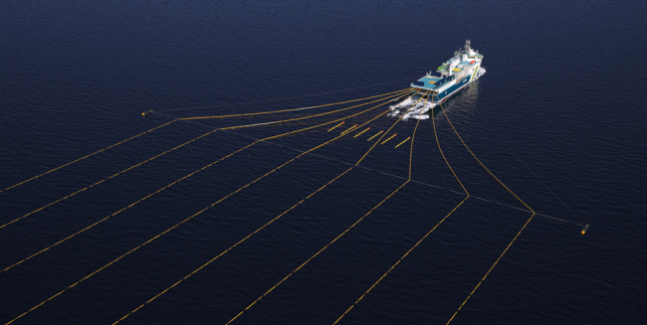
An illustration of Tamhae 3rd exploring the seabed. The short rods placed close to the bow are air guns that emit loud sounds, seismic waves, towards the seabed. The long ropes are ‘streamers’ that detect seismic waves that hit the seabed and return, allowing them to determine what minerals are located under the sea. Provided by the Korea Institute of Geoscience and Mineral Resources,
,
,
,
,
, ‘The collected survey information is transmitted to the ‘Science Lab,’ a facility inside Tamhae 3rd. The Science Lab functions as the brain that analyzes and stores various information like a human.’,
,
,
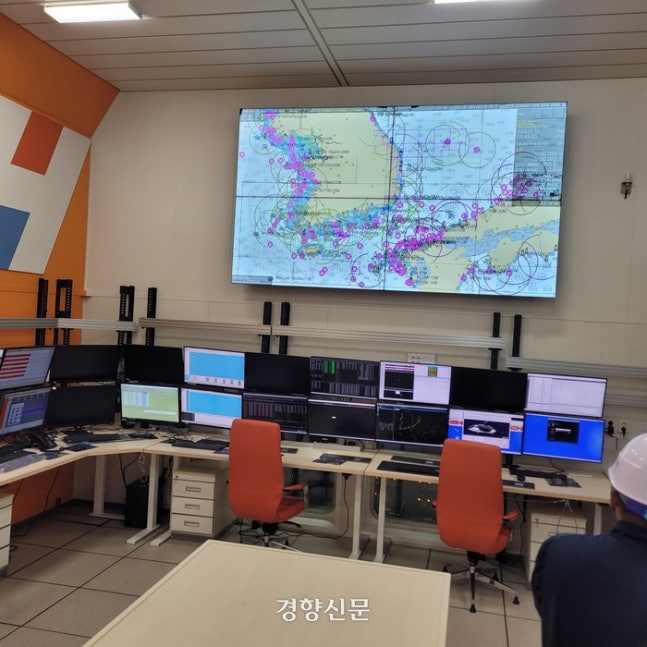
The ‘Science Lab’ installed inside Tamhae 3rd. It is where information obtained from various survey equipment deployed in the deep sea is consolidated. Reporter Lee Jung-ho,
,
, ‘Upon entering the Science Lab that day, a large screen displaying a map of the area around Korea caught my eye. In a space of about 80 square meters, multiple monitors, computers, and servers were crammed in. The area was designed for the aggregated deep-sea information collected by various survey equipment, including the air gun and the streamer, to be processed computationally here.’,
,
, ‘Choi Yoon-seok, director of the Deep-Sea Geological Survey Research Center at the Korea Institute of Geoscience and Mineral Resources, explained, “With technologies like seismic waves and various equipment, we can explore the inside of the earth as if we are looking at the inside of a body using magnetic resonance imaging (MRI) or computed tomography (CT).”‘,
,
, ‘What is Tamhae 3rd using these technologies to find? It is deep-sea resources. When seismic waves collide with objects in solid, liquid, or gas states, the amplitude changes. This is similar to a person’s voice getting louder or softer. By analyzing these amplitude changes, we can locate fluids such as oil or gas trapped in solid rocks.’,
,
, ‘Kim Byung-yeop, director of the Deep-Sea Energy Research Division at the Korea Institute of Geoscience and Mineral Resources, stated, “While Korea has explored resources around its coasts in the past, we plan to conduct renewed exploration using the latest technology provided by Tamhae 3rd.”‘,
,
, ‘There are expectations that Tamhae 3rd’s activities in the ‘7th basin’ off the southern coast of Jeju Island will enhance Korea’s capabilities in exploration. The 7th basin is located between Korea and Japan, and it is expected to be an area where a large amount of underground resources are stored.’,
,
, ‘Although a 50-year joint development agreement between Korea and Japan was ratified in 1978, there has been little progress in extraction for decades due to Japan’s passive stance. With the agreement approaching expiration, there are speculations that Japan may claim sovereignty over the resources when the agreement ends. The possibility of disputes between Korea and Japan cannot be ruled out. With the arrival of Tamhae 3rd, there is a perspective that Korea now has a technological means to assist in joint resource surveys if needed.’,
,
, ‘Tamhae 3rd will embark on its first mission in the Gunsan Basin in the West Sea this month. The plan is to search for underground storage sites for long-term isolation of greenhouse gas carbon dioxide. Next year, it is scheduled to head to the Pacific Ocean to conduct rare earth mineral exploration.’,
,
, ‘It is also anticipated that Tamhae 3rd will be able to explore gas hydrates, deep-sea resources consisting of a combination of methane gas and ice. In 2007, Tamhae 2nd confirmed the physical presence of gas hydrates in the East Sea, ranking fifth in the world. Center Director Choi said, “With Tamhae 3rd, we expect to be able to explore gas hydrates not only in the East Sea but also in the ocean.”‘,
,
, ‘\n’

